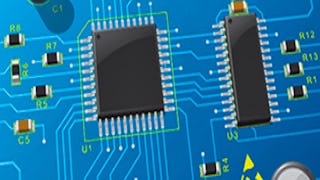This course gives you a complete insight into the modern design of digital systems fundamentals from an eminently practical point of view. Unlike other more "classic" digital circuits courses, our interest focuses more on the system than on the electronics that support it. This approach will allow us to lay the foundation for the design of complex digital systems.



Digital Systems: From Logic Gates to Processors



Instructeurs : Elena Valderrama
103 753 déjà inscrits
Inclus avec 
(836 avis)
Compétences que vous acquerrez
- Catégorie : Computer Architecture
- Catégorie : Problem Solving
- Catégorie : Algorithms
Détails à connaître

Ajouter à votre profil LinkedIn
17 devoirs
Découvrez comment les employés des entreprises prestigieuses maîtrisent des compétences recherchées


Obtenez un certificat professionnel
Ajoutez cette qualification à votre profil LinkedIn ou à votre CV
Partagez-le sur les réseaux sociaux et dans votre évaluation de performance

Il y a 12 modules dans ce cours
This module is includes a number of general explanations about how the course will run and about the virtual machine you should install on your computer to answer the different quizzes.
Inclus
1 vidéo10 lectures
This module presents a series of tests you can use to check your level of knowledge about numbering systems and the use of pseudocode to describe algorithms.
Inclus
2 vidéos2 lectures2 devoirs
<b><font size=4 color=#B22222><b>Click on "v More" to read the purpose of this module</b></font> </b> <br/><br/>This module is an introduction to Digital Systems. Here you will find:<ol><li>A set of videos_L covering issue 1 and the corresponding exercises, </li><li>Two videos_P introducing the processor that we will design along the course, and</li><li>Some video-based explanations; a wiki and some FAQs about how VerilUOC_Desktop tool functions.<br/> You will have to use VerilUOC_Desktop in the next module</li></ol> Read the "Lesson Index" in the "Index and PDF files" section and the "README" in the VerilUOC_Desktop section for more information.
Inclus
5 vidéos3 lectures2 devoirs
<b><font size=4 color=#B22222><b>Click on "v More" to read the purpose of this module</b></font> </b> <br/><br/>This module introduces combinational circuits, logic gates and boolean algebra, all of them items necessary to design simple combinational circuits.<br/> Read the "Index of lessons" for more information. <br/><br/><b>To solve the exercises in this module you will need to use VerilUOC_Desktop. Look at the module "VerilUOC_Desktop tools" to learn how to use it.</b>
Inclus
5 vidéos3 lectures2 devoirs
<b><font size=4 color=#B22222><b>Click on "v More" to read the purpose of this module</b></font> </b><br/><br/>From this module you will need to use VerilUOC_Desktop to do some of the exercises in the quizzes. VerilUOC_Desktop is a software package based on Logisim, enhanced with a number of modules to enable:<ul><li>Enter Boolean equations (BoolMin),</li><li>Enter digital circuits and check them according the problem statement (VerilCirc), and</li><li>Enter chronograms (time-charts) and check that they are correct (VerilChart).</li></ul>This section contains two videos explaining how these three tools work. By now you only need to use VerilCirc and BoolMin, so if you are pushed for time, you might postpone VerilChart for later. Obviously, it is impossible to cover in these two videos all eventualities you can find while working with VerilUOC_Desktop tools. In case of doubt, look at the VerilUOC_Desktop wiki, look at the FAQs or post your problems in the forums. There are specific forums for VerilCirc, BoolMin and VerilChart.
Inclus
2 vidéos3 lectures
<b><font size=4 color=#B22222><b>Click on "v More" to read the purpose of this module</b></font> </b><br/><br/>We continue the study of combinational circuits. While in the previous module we were working on the classical design techniques of combinational circuits, this one is focused on other issues such as a brief introduction to computer aided design tools (CAD tools), or the direct synthesis of combinational circuits from its algorithmic description.<br/> Read the "Lesson index" for more information. <br><br/><b>To solve the exercises in this module VerilUOC_Desktop is needed. </b>Remember that the module "VerilUOC_Desktop tols" contains all the information you need about this tool.
Inclus
5 vidéos3 lectures2 devoirs
<b><font size=4 color=#B22222><b>Click on "v More" to read the purpose of this module</b></font> </b><br/><br/>Arithmetic circuits are an essential part of many digital circuits and thus deserve a particular treatment. <ul><li> The first part of this module presents some implementations of the basic arithmetic operations. Only operations with naturals (non-negative integers) are considered. </li><li>The second part of this module introduces the basics of VHDL with the goal of providing enough knowledge to understand its usage throughout this course and start developing basic hardware models.</li></ul>
Inclus
10 vidéos9 lectures1 devoir
<b><font size=4 color=#B22222><b>Click on "v More" to read the purpose of this module</b></font> </b><br/><br/>This is the first module dedicated to Sequential Circuits (Digital Systems with Memory).<br/><b>To solve the quizzes you will need VerilUOC_Desktop</b>.
Inclus
7 vidéos3 lectures2 devoirs
<b><font size=4 color=#B22222><b>Click on "v More" to read the purpose of this module</b></font> </b><br/><br/>This second module dedicated to Sequential Circuits deals with particular sequential circuits that are building blocks of larger circuits, namely registers, counters and memory blocks.
Inclus
4 vidéos3 lectures2 devoirs
<b><font size=4 color=#B22222><b>Click on "v More" to read the purpose of this module</b></font> </b><br/><br/>This module deals with two topics: <ol><li>In previous lessons, the relation between algorithms (programming language structures) and combinational circuits has been commented. This relation also exists between algorithms and sequential circuits. We will explore this relation in the current module.</li><li>The second topic we will see is the definition and VHDL modelling of Finite State Machines.</li></ol>
Inclus
5 vidéos4 lectures2 devoirs
<b><font size=4 color=#B22222><b>Click on "v More" to read the purpose of this module</b></font> </b><br/><br/>This last module presents some basic information about manufacturing technologies, as well as about implementation strategies, and synthesis and implementation tools.
Inclus
4 vidéos2 lectures2 devoirs
´´
Inclus
3 lectures
Instructeurs



Offert par
En savoir plus sur Electrical Engineering

Birla Institute of Technology & Science, Pilani

Princeton University

Microsoft
Pour quelles raisons les étudiants sur Coursera nous choisissent-ils pour leur carrière ?




Avis des étudiants
836 avis
- 5 stars
63,63 %
- 4 stars
21,77 %
- 3 stars
5,98 %
- 2 stars
2,39 %
- 1 star
6,22 %
Affichage de 3 sur 836
Révisé le 20 sept. 2020
A very good discussion on fundamental considering the focus on application such as design of a processor
Révisé le 10 juil. 2022
The most interesting part of this course, for me, was the graded quiz. It was challenging , but nice.I really learnt a lot.Thank you
Révisé le 9 sept. 2019
It's not a easy course for me, but the practice exercise is enough for me to get deeper understanding in course content.

Ouvrez de nouvelles portes avec Coursera Plus
Accès illimité à 10,000+ cours de niveau international, projets pratiques et programmes de certification prêts à l'emploi - tous inclus dans votre abonnement.
Faites progresser votre carrière avec un diplôme en ligne
Obtenez un diplôme auprès d’universités de renommée mondiale - 100 % en ligne
Rejoignez plus de 3 400 entreprises mondiales qui ont choisi Coursera pour les affaires
Améliorez les compétences de vos employés pour exceller dans l’économie numérique
Foire Aux Questions
You can request the certificate at any time: before, during or once you finish the course.
· The course name
· The instructor's signature
· The logo of the partner institution offering the course
· A verification URL that allows others to check the Certificate's authenticity
· A statement that Coursera has confirmed the identity of the learner who completed the course
· Academic credit from the partner institution offering the course
· The final grade you got in the course
· Your ID photo
· The hours you spent working on coursework
· A printed or mailed copy of the Course Certificate.
Certificates are provided as downloadable PDF files, which you can print yourself. You can also share them electronically.
Unfortunately, Coursera cannot provide course Certificates with any more information than they already include.
Plus de questions
Aide financière disponible,






